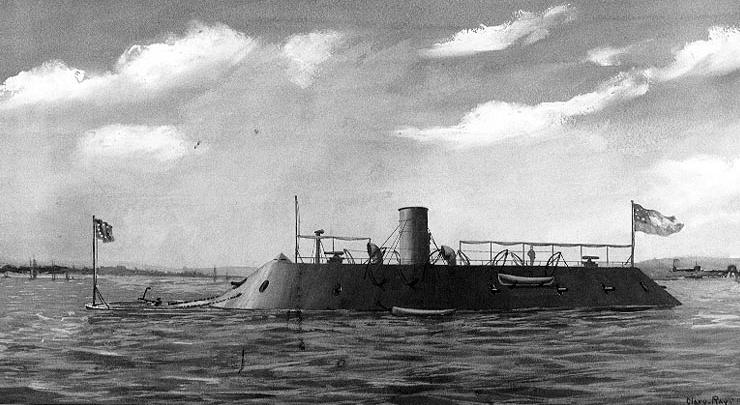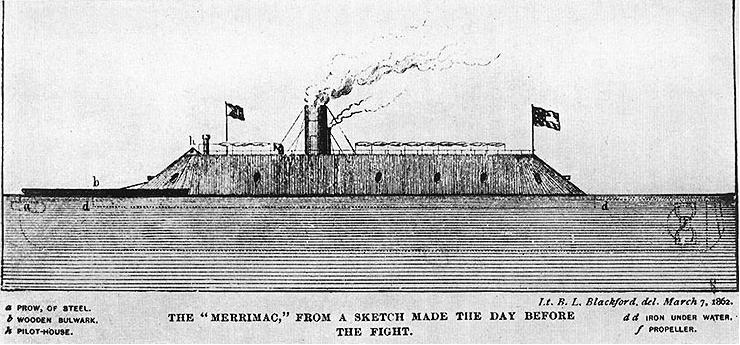CSS Virginia was an ironclad warship in the service of the Confederate States Navy that fought in history's first engagement between iron-armored warships: the Battle of Hampton Roads, March 8–9, 1862, during the American Civil War. Previously, she was a steam sail frigate named USS Merrimac, and still referred to by that name today.

Service as USS Merrimac
Virginia began life as the second ship of the United States Navy named Merrimac and was launched by the Boston Navy Yard on 15 June 1855 and commissioned on 20 February 1856. Capt. Garrett J. Pendergrast in command.
Shakedown took the new screw frigate to the Caribbean and to western Europe. Merrimac visited Southhampton, Brest, Lisbon, and Toulon before returning to Boston and decommissioning on 22 April 1857 for repairs. Recommissioning 1 September 1857, Merrimac got underway from Boston Harbor on 17 October as flagship for the Pacific Squadron. She rounded Cape Horn and cruised the Pacific coast of South and Central America until heading for home on 14 November 1859. Upon returning to Norfolk, she decommissioned on 16 February 1860.
Merrimac was still in the ordinary during the crisis preceding Abraham Lincoln’s inauguration. Soon after becoming Secretary of the Navy, Gideon Welles took action to prepare the frigate for sea, planning to move her to Philadelphia.
The day before the firing on Fort Sumter, Welles directed that “great vigilance be exercised in guarding and protecting” Norfolk Navy Yard and her ships.
On the afternoon of 17 April, the day Virginia seceded, Engineer in Chief B. F. Isherwood managed to get the frigate’s engines lit off, but the previous night, secessionists had sunk lightboats in the channel between Craney Island and Sewell’s Point, blocking Merrimac.
On the 20th, before evacuating the Navy Yard, the U.S. Navy burned Merrimac to the waterline and sank her to preclude capture.
Conversion to Ironclad

The Confederates, in desperate need of ships, raised Merrimac and rebuilt her as an ironclad ram, according to a design prepared by Lt. J. M. Brooke, CSN. Commissioned as CSS Virginia on 17 February 1862, the ironclad was the hope of the Confederacy to destroy the wooden ships in Hampton Roads and to end the Union blockade, which had already seriously hurt the South.
Despite an all‑out effort to complete her, Virginia still had workmen on board when she sailed out into Hampton Roads on 8 March 1862, tended by CSS Raleigh and Beaufort and accompanied by Patrick Henry, Jamestown, and Teaser.
Captain Franklin Buchanan, CSN, commanding Virginia, was singled out as the first victim sailing sloop USS Cumberland, anchored west of Newport News. In taking a position, Virginia passed the USS Congress and exchanged broadsides, suffering no injury while causing considerable damage.
She crossed Cumberland’s bow, raking her with a lethal fire, before finishing off the wooden warship with a thrust of her iron ram. Gallantly fighting her guns as long as they were above water, Cumberland sank, taking one‑third of her crew, 121 men, and part of Virginia’s ram down with her.
Virginia then turned her attention to Congress, which had grounded. Assisted by the lighter ships of the South’s James River Squadron, Virginia opened fire from a distance, forcing Congress to haul down her colors.
As CSS Beaufort and Raleigh approached Congress to receive the surrender of her crew, Federal troops ashore, not understanding the situation, opened a withering fire and wounded Buchanan, who retaliated by ordering a hot shot and incendiary shell to pore into Congress.
The latter, ablaze and unable to bring a single gun to bear, hauled down her flag for the last time. She continued to burn until exploding about midnight.
Virginia did not emerge unscathed. Her stack was riddled, causing a loss of power, and she was initially underpowered. Two large guns were out of order, her armor loosened, and her ram was lost.
Nevertheless, she went on to attack the USS Minnesota, but shallow water prevented her from getting close enough to do her former sister frigate serious damage. Virginia anchored that night at Sewell’s Point for repairs.
Flag Officer Buchanan was taken ashore to the hospital, and Lt. Catesby ap R. Jones, CSN, who had conned the ironclad after Buchanan had been wounded, assumed command.
Battle with the Monitor
On the following morning, Virginia returned to battle, but in the night, the Union ironclad USS Monitor had arrived in the nick of time to defend the fleet in Hampton Roads. The ensuing inconclusive battle, the first-ever fought between powered ironclads, revolutionized naval warfare.
As Virginia steamed into Hampton Roads toward grounded Minnesota, Monitor moved out of the steam frigates shadow to challenge the Confederate ironclad. Minnesota’s commander, Capt. G. J. Van Brunt described the ensuing action. “Gun after gun was fired by the Monitor, which was returned with whole broadsides from the rebels with no more effect, apparently, than so many pebblestones thrown by a child.
After a while, they commenced maneuvering, and we could see the little battery point her bow for the rebels, with the intention, as I thought, of sending a shot through her bow porthole; then she would shoot by her and rake her through her stern.
In the meantime, the rebel was pouring broadside after broadside, but when they struck the bombproof tower, the shot glanced off without producing any effect.”
Shortly before noon, a shot from Virginia struck Monitor’s pilothouse, driving dust through the eyeslit through which Lieutenant John L. Worden was conning the ship and temporarily blinding him. Thinking that the pilothouse was seriously damaged, if not destroyed, Worden ordered the ship to sheer off to shallow water. At the same time, Virginia headed back toward Sewell’s Point.
Installation of a new ram and other repairs and alterations kept Virginia in drydock at Norfolk for almost a month.
Flag Officer Josiah Tattnall, CSN, appointed on 25 March 1862 as Commander of Confederate Naval Forces, selected Virginia as his flagship.
Final month
Virginia returned to Hampton Roads on 11 April; under her protection, CSS Jamestown and CSS Raleigh captured three Union transports. Strategic considerations precluded a second Monitor‑Virginia duel.
Monitor’s mission was to contain Virginia in support of General George B. McClellan’s campaign on the peninsula, and Virginia safeguarded the important Norfolk area and the mouth of the James River.
When forced to evacuate Norfolk, the Confederates tried to take Virginia up the James River, but her deep draft prevented it, so they destroyed her on 11 May 1862.
